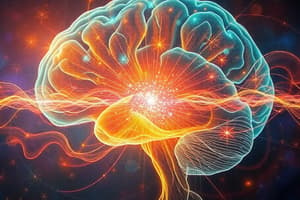Podcast
Questions and Answers
Olfactory pathways are unique because the second neuron directly projects to the cortex, bypassing any relay in the thalamus.
Olfactory pathways are unique because the second neuron directly projects to the cortex, bypassing any relay in the thalamus.
True (A)
The hippocampus is located inferior to the parahippocampal gyrus.
The hippocampus is located inferior to the parahippocampal gyrus.
False (B)
The pes hippocampi, when viewed from above, resembles the shape of a clenched fist's phalanges.
The pes hippocampi, when viewed from above, resembles the shape of a clenched fist's phalanges.
True (A)
The alveus is composed of neuronal cell bodies situated on the ventricular surface of the hippocampus.
The alveus is composed of neuronal cell bodies situated on the ventricular surface of the hippocampus.
Signup and view all the answers
Fimbriae are formed by the medial thickening of the axons comprising the alveus.
Fimbriae are formed by the medial thickening of the axons comprising the alveus.
Signup and view all the answers
The dentate gyrus is situated medially to the fimbria when viewed from the medial aspect.
The dentate gyrus is situated medially to the fimbria when viewed from the medial aspect.
Signup and view all the answers
The fornix commissure is considered a true commissure in the classical sense of white matter tracts.
The fornix commissure is considered a true commissure in the classical sense of white matter tracts.
Signup and view all the answers
Anterior fibers of the fornix predominantly terminate in the septal nuclei located near the lamina terminalis.
Anterior fibers of the fornix predominantly terminate in the septal nuclei located near the lamina terminalis.
Signup and view all the answers
The mamillothalamic tract connects the mamillary body to the posterior pole of the thalamus.
The mamillothalamic tract connects the mamillary body to the posterior pole of the thalamus.
Signup and view all the answers
The induseum griseum, a layer of grey matter, is located inferior to the corpus callosum.
The induseum griseum, a layer of grey matter, is located inferior to the corpus callosum.
Signup and view all the answers
The hippocampus is involved in the formation of memories related to more recent experiences, with damage to it specifically affecting recent memories but leaving distant or older memories mostly untouched.
The hippocampus is involved in the formation of memories related to more recent experiences, with damage to it specifically affecting recent memories but leaving distant or older memories mostly untouched.
Signup and view all the answers
The amygdaloid body and the globus pallidus are key components of the limbic system and contribute to functions like behavior, mood, and memory.
The amygdaloid body and the globus pallidus are key components of the limbic system and contribute to functions like behavior, mood, and memory.
Signup and view all the answers
Mitral cells, located within the olfactory bulb, receive input directly from the olfactory nerve filaments that pass through the ethmoid bone's cribriform plate.
Mitral cells, located within the olfactory bulb, receive input directly from the olfactory nerve filaments that pass through the ethmoid bone's cribriform plate.
Signup and view all the answers
The olfactory tract, an extension of the brain's gray matter, is positioned next to the gyrus rectus and underneath the temporal lobe.
The olfactory tract, an extension of the brain's gray matter, is positioned next to the gyrus rectus and underneath the temporal lobe.
Signup and view all the answers
The limbic system, once thought to be linked exclusively with the olfactory tracts, plays a multifaceted role encompassing behavior, mood, and memory.
The limbic system, once thought to be linked exclusively with the olfactory tracts, plays a multifaceted role encompassing behavior, mood, and memory.
Signup and view all the answers
Fibers from the olfactory tract reach the uncus and surrounding cortical areas, creating connections with the visual cortex.
Fibers from the olfactory tract reach the uncus and surrounding cortical areas, creating connections with the visual cortex.
Signup and view all the answers
The fornix, a C-shaped structure, connects the hippocampus and mammillary bodies which are involved within the limbic system.
The fornix, a C-shaped structure, connects the hippocampus and mammillary bodies which are involved within the limbic system.
Signup and view all the answers
The limbic system's components include the septal areas near the lamina terminalis, the insula, the cingulate gyrus, and the parahippocampal gyrus; the calcarine sulcus and Wernicke's area are not typically considered part of this system.
The limbic system's components include the septal areas near the lamina terminalis, the insula, the cingulate gyrus, and the parahippocampal gyrus; the calcarine sulcus and Wernicke's area are not typically considered part of this system.
Signup and view all the answers
Lesions affecting the fornix can lead to difficulties in spatial navigation and episodic memory, functions associated with hippocampal connectivity.
Lesions affecting the fornix can lead to difficulties in spatial navigation and episodic memory, functions associated with hippocampal connectivity.
Signup and view all the answers
The anterior perforated substance, located beneath the frontal lobe, serves as a relay point for some olfactory tract fibers, enabling their connection to the adjacent cortical regions.
The anterior perforated substance, located beneath the frontal lobe, serves as a relay point for some olfactory tract fibers, enabling their connection to the adjacent cortical regions.
Signup and view all the answers
Flashcards
Limbic System
Limbic System
The limbic system is a complex set of structures involved in emotions, behavior, and memory.
Hippocampus
Hippocampus
A major part of the limbic system responsible for memory formation, especially recent events.
Olfactory Pathways
Olfactory Pathways
Neural pathways that carry scent information from the olfactory bulbs to the brain.
Amygdaloid Body
Amygdaloid Body
Signup and view all the flashcards
Olfactory Bulb
Olfactory Bulb
Signup and view all the flashcards
Cingulate Gyrus
Cingulate Gyrus
Signup and view all the flashcards
Fornix
Fornix
Signup and view all the flashcards
Septal Area
Septal Area
Signup and view all the flashcards
Insula
Insula
Signup and view all the flashcards
Olfactory Nerve
Olfactory Nerve
Signup and view all the flashcards
Alveus
Alveus
Signup and view all the flashcards
Fimbria
Fimbria
Signup and view all the flashcards
Commissure of the Fornix
Commissure of the Fornix
Signup and view all the flashcards
Septal Nuclei
Septal Nuclei
Signup and view all the flashcards
Mamillary Body
Mamillary Body
Signup and view all the flashcards
Induseum Griseum
Induseum Griseum
Signup and view all the flashcards
Study Notes
Limbic System Overview
- The limbic system, surrounding the corpus callosum and diencephalon, initially associated with olfaction, now understood as having broader functions: behavior, mood, and memory.
- Damage to the hippocampus, a major limbic component, causes loss of recent memory, but distant events remain intact.
Limbic System Components
- Septal and piriform areas: Cerebral cortex near the lamina terminalis.
- Uncus, insula, cingulate, and parahippocampal gyri: Brain structures.
- Amygdaloid body: A brain structure.
- Hippocampus, fimbria, fornix, and mammillary body: Interconnected structures.
- Some authorities include the hypothalamus and anterior thalamus due to their functional connections with limbic structures.
Olfactory Pathways
- The olfactory tract, a white matter extension like the optic nerve, lies in the olfactory sulcus.
- The olfactory tract's anterior end is the olfactory bulb, containing mitral cells.
- Olfactory nerve filaments synapse at the mitral cells after passing through the cribriform plate.
- Mitral cell axons return in the tract, reaching regions like the uncus and parahippocampal gyrus, and complex connections with the limbic system.
- There are two neurons from olfactory receptors to cortex. The second neuron reaches the cortex without thalamic relay.
- The olfactory bulb also connects with the hypothalamus and brainstem, for visceral and somatic effects distinct from conscious sense.
Hippocampus
- The hippocampal sulcus projects into the inferior horn of the lateral ventricle as the hippocampus.
- The anterior hippocampus (pes hippocampi) resembles clenched knuckles.
- The alveus, a white matter film, covers the ventricular surface of the hippocampus, thickening medially to form the fimbria.
- The fimbria detaches as the posterior pillar of the fornix.
- The dentate gyrus is a part of the hippocampus between the fimbria and the parahippocampal gyrus.
Fornix
- The fornix is a major efferent pathway from the hippocampus.
- Continuous with the fimbria, it curves behind the thalamus, joining its fellow in a partial decussation (fornix commissure).
- The fornix is an association tract, not a true commissure.
- The fornix body lies below the corpus callosum.
- Anterior fornix columns arch in front of the thalami, forming interventricular foramina margins.
- Anterior fornix fibres mainly go to septal nuclei.
- Posterior fibres go to the thalamus or mammillary body.
- Fibres from the mammillary body form the mamillothalamic tract to the thalamus, relaying to the cingulate gyrus.
- The induseum griseum and longitudinal striae are connected to the fornix.
Studying That Suits You
Use AI to generate personalized quizzes and flashcards to suit your learning preferences.
Description
This quiz delves into the structure and function of the limbic system, including its role in behavior, mood, and memory. You'll learn about the key components such as the hippocampus, amygdala, and olfactory pathways. Test your knowledge of the interconnected structures and their significance in the brain.




